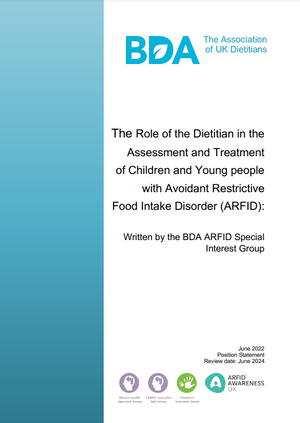Sian Taylor describes how an ARFID Special Interest Group went about the process of writing a BDA Position Statement on the condition.
Access the Position Statement on the CAMHS Specialist Sub-Group webpages here.
Avoidant restrictive food intake disorder (ARFID) was introduced as a formal diagnostic term included in the ‘Feeding and Eating Disorders’ section of the International Classification of Diseases (ICD) published in ICD-11 (2018).1
ARFID is a feeding disorder describing significant restrictions to the amount or type of food eaten. This may be driven by high sensitivity to the appearance, smell or taste of food, fear of aversive consequences such as being sick or choking, or lack of interest in food. These patterns can result in significant nutritional deficiencies and/or weight changes.2 Its presentation varies between individuals and not all the symptoms need to be present at any one time.3 This eating disorder affects children and adults alike and by the age of nine years, children can present with a chronic pattern of eating that has persisted for several years.

Clinically many dietitians recognise that this is not a new problem but a new definition, and we have the skills, experience and expertise to work with these patients. In the past, some of these cases may have presented as extreme fussy or picky eaters, with food allergies/intolerance or as suspected anorexia nervosa.
What is the role for dietitians?
The role of a mental health or CAMHS specialist dietitian in an eating disorder multidisciplinary team has been widely recognised.4,5 Historically, some teams have not been appropriately resourced for the demand on the team. There is a lack of published guidance on the role of dietitians working with ARFID. Nutritional deficiency is a key risk factor in this population and should be considered at clinical assessment and addressed during treatment. Dietitians are, of course, well placed to provide the nutritional assessment and dietary management, and increasingly eating disorders (ED), CAMHS, paediatric and other dietitians are being approached to support these patients within current caseloads and department structures such as community paediatrics, eating disorders or primary care.
Fifteen dietitians joined initially to form an ARFID Special Interest Group (SIG). This was driven by a desire to understand how we could provide the best service for our patients and how we could ensure that going forward service developments included appropriate dietetic resource – the right skill set and clinical capacity. (This group now numbers 150 – there is clearly much interest in this area.) An evidence-based outpatient care pathway was published around this time by Dr Rachel Bryant-Waugh, which supported our thinking and included dietitians in assessment and dietary management as part of a multidisciplinary team.6
The process of finding a position
The ARFID SIG grew in numbers and diversity and, from this, a small and enthusiastic core eight dietitians met regularly via video link. The group included clinicians working in services for children and adolescents. Two of the group worked in newly formed ARFID teams and the remaining in eating disorders and paediatrics. CAMHS, inpatients, outpatients and specialist services and hospital settings were all represented. The skill mix of the group meant that each brought an important perspective to the table and soon one of the challenges was evident. In the absence of clear clinical pathways these patients are referred to a wide range of services with no clear front door and plan, and this varied regionally.
We set out to write a position statement that demonstrated the nutritional management of ARFID as a dietetic role and responsibility across services and teams, as clinical management of ARFID developed in the UK.
Difficulties encountered
One of the challenges was that individuals’ current roles and experience was so varied, with some dietitians working in well-supported and resourced teams with supportive line management and others in less fortunate positions. The drive was the desire to establish our professional role within ARFID that we could all agree on. This aspect also provides one of the strengths of the final document, in that it has been written in such a way that it will be helpful to clinicians working in a range of settings and with varied clinical contexts.
The evidence base was limited and shifting. Literature reviews undertaken in 2019 and 2022, by the author, yielded some stronger evidence for the nutritional deficiencies but nothing that substantially evidenced the detailed and specific role of a dietitian.
Peer review process
The initial draft of the position statement was shared with some of the key professionals that we had each encountered in seeking to understand more about ARFID. Dr Rachel Bryant-Waugh was instrumental in driving the ICD-11 and DSM classification, and was supportive in reading and commenting on our first draft. Professor Glen Waller had previously given some ARFID training and gave constructive comments. He emphasised the clinical importance of working in a multidisciplinary team and emphasising the skills dietitians have and the contribution they can make within an ARFID service.
ARFID Awareness UK (AAUK) was consulted to include the patients’ and carers’ voices. Dietitians Dr Rosan Meyer and Dr Luise Marino and Psychologist Dr Gillian Harris were all very helpful in providing useful feedback.
We approached commissioners, colleagues in paediatrics (Dr Damien Wood) and the BDA Mental Health Group, the CAMHS sub-group and the Paediatric Specialist Group.
Getting this early draft out was valuable, informing key professionals that dietitians were making a noise about the need to ‘hold some space’ in this speciality and in developing services. The document was revised and rewritten by the group during the COVID pandemic and all with busy clinical commitments.
The position statement

Access the position statement here.
The aim of the position statement is to raise awareness that dietitians are central to the assessment and treatment of children and young people with ARFID. We have written a document which we hope will be useful for dietitians when they are asked what is needed for an ARFID service, and we hope it will influence and support service users and providers.
What the position statement includes:
- What is ARFID?
- Nutritional risks of ARFID
- Role and responsibility of specialist dietitians
- Staffing recommendations
- The extended roles of dietitians
- References
Where are we now?
We firmly believe that there is a key role for dietitians in the assessment and treatment of children and young people with ARFID. Bourne7,8 describes the food restriction in ARFID as being as persistent as having clinical symptoms of weight loss, nutritional deficiency or dependence on nutritional supplements. Individual case reports found scurvy (Vitamin C deficiency), eye disorders (Vitamin A deficiency) and low weight for age in the ARFID population.9 Farag et al.,10 Harshman et al.,11 and Schmit et al.12 in larger observational studies all identify nutritional inadequacy to varying degrees in children and young people with ARFID.
There is opportunity to develop the evidence base for dietitians working in this field. We expect that this statement will also enable clinicians to approach their managers and clinical teams and provide evidence to support them in their request for specialist dietitians to work with ARFID teams and services.
The statement will be published on the BDA website and be widely available for its members.
Next steps
The ARFID SIG continues. We meet regularly, every two months, and share clinical experiences and training opportunities. We are working to become a formal sub-group of the Mental Health Group and retain close alignment with the Paediatric Specialist Group. The CAMHS BDA sub-group and ARFID SIG are holding some joint training with the Paediatric Specialist Group in October, and we have plans for a comprehensive suite of training in the future. We plan to develop a tool kit to provide more in-depth how-to guides around the assessment and different treatment options when working clinically with children and young people with ARFID. We recommend that dietitians obtain appropriate clinical supervision when working with this population.
We recognise that ARFID is an evolving service and therefore the paper will be reviewed in two years’ time.
References
- World Health Organization. (2018). International Classification of Diseases for mortality and morbidity statistics (11th Revision).
- Claudino, A.M. Pike, K.M. Hay, P. Keely, J. W. et al. The classification of feeding and eating disorders in the ICD-11: results of a field study comparing proposed ICD-11 guidelines with existing ICD-10 guidelines. BMC Medicine 201917(93) 1 – 17. Available from https://doi.org/10.1186/s 12916-019-1327-4 [Accessed 10 March 2021].
- Bryant-Waugh, R. (2020) In ARFID Avoidant Restrictive Food Intake Disorder A Guide for Parents and Cares. London: Routledge
- National Institute for Health and Care Excellence (2017) Eating Disorders: recognition and treatment (Nice guidance 69) Available from www.nice.org.uk/guidance/ng69 [Accessed 8 April 2021].
- Jeffrey, S. & Heruc, G.(2020) Balancing nutrition management and the role of dietitians in eating disorder treatment. Journal of Eating Disorders 8(6) [Online] Available from: https://doi.org/10.1186/s40337-020-00322-x [Accessed 25 April 2022].
- Bryant-Waugh, R., Loomes R., Munuvea, A., Rhinda., (2021) Towards an evidence based outpatient care pathway for children and young people with Avoidant Restrictive Food Intake Disorder. Journal of Behavioural and Cognitive Therapy [online], 31 (1) March 2021. Available from: https://doi.org/10.1016/j.jbct.2020.11.001 [Accessed 10 February 2022].
- Bourne, L., Bryant-Waugh, R., Cook, J. and Mandy, W. (2020) Avoidant/restrictive food intake disorder: A systematic scoping review of the current literature. Psychiatry research [online], 288 June 2020. Available from: https://doi.org/10.1016/j.psychres.2020.112961 [Accessed 10 March 2021].
- 8 Bourne, L., Mandy, W., Bryant-Waugh, R. (2021) Avoidant/restrictive food intake disorder and severe food selectivity in children and young people with autism: A scoping review, Dev Med Child Neurol. [online], 2022. Available from: https://doi.org/10.1111/dmen.15139 [Accessed 22 April 2022].
- Meyer, R. and Marino, L. (2021) ARFID: Help, my child won’t eat [online] British Dietetic Association. Available from BDA Homepage resource library [Accessed 10 March 2021].
- Farag, F. Sims, A., Strudwick K et al. (2021) Avoidant/restrictive food intake disorder and autism spectrum disorder: clinical implications for assessment and management. Developmental Medicine and Child Neurology [Online] Available from: https://doi.org/10.1111dmcn.14977 [Accessed 10 April 2022].
- Harshman, S., Wons, O et al (2019) A diet high in processed foods, total carbohydrates and added sugars, and low in vegetables and protein is Characteristic of youth with avoidant/restrictive food intake disorder. Nutrients 11(9) [Online] Available from: https://doi.org/10.3390/nu 11092013 [Accessed 22 April 202].
- Schmit, R., Hiemish, A. et al., (2021) Macro and micronutrient intake in children with avoidant/restrictive food intake disorder and autism spectrum disorder: Nutrients
- [Online] Available from: https://www.ncbi.nich.gov/pmc/articles/PMC7911718/ [Accessed 10 March 2022].







